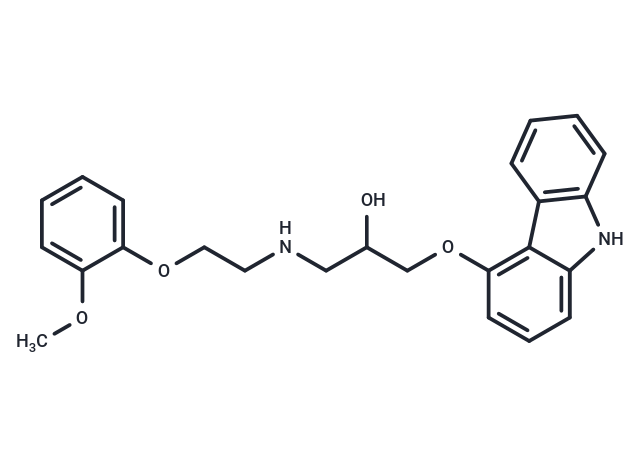Shopping Cart
- Remove All
 Your shopping cart is currently empty
Your shopping cart is currently empty

Carvedilol (SKF 105517) Phosphate is the phosphate salt form of carvedilol, a racemic mixture and adrenergic blocking agent with antihypertensive activity and devoid of intrinsic sympathomimetic activity. The S enantiomer of carvedilol nonselectively binds to and blocks beta-adrenergic receptors, thereby exerting negative inotropic and chronotropic effects, and leading to a reduction in cardiac output. In addition, both enantiomers of carvedilol bind to and block alpha 1-adrenergic receptors, thereby causing vasodilation and reducing peripheral vascular resistance.

| Pack Size | Price | Availability | Quantity |
|---|---|---|---|
| 25 mg | TBD | Backorder | |
| 50 mg | TBD | Backorder | |
| 100 mg | TBD | Backorder | |
| 200 mg | TBD | Backorder | |
| 500 mg | TBD | Backorder | |
| 1 mL x 10 mM (in DMSO) | TBD | Backorder |
| Description | Carvedilol (SKF 105517) Phosphate is the phosphate salt form of carvedilol, a racemic mixture and adrenergic blocking agent with antihypertensive activity and devoid of intrinsic sympathomimetic activity. The S enantiomer of carvedilol nonselectively binds to and blocks beta-adrenergic receptors, thereby exerting negative inotropic and chronotropic effects, and leading to a reduction in cardiac output. In addition, both enantiomers of carvedilol bind to and block alpha 1-adrenergic receptors, thereby causing vasodilation and reducing peripheral vascular resistance. |
| Targets&IC50 | β/α1-adrenoceptor:3.8 μM, LDL oxidation:3.8 μM |
| In vitro | Carvedilol rapidly inhibits Fe(++)-initiated lipid peroxidation, measured as thiobarbituric acid reactive substance (TBARS), in rat brain homogenate with an IC50 of 8.1 mM. Carvedilol protects against Fe(++)-induced alpha-tocopherol depletion in rat brain homogenate with an IC50 of 17.6 mM. Carvedilol dose-dependently decreases the intensity of the DMPO-OH signal with an IC50 of 25 mM. [1] Carvedilol has inverse efficacy for stimulating G(s)-dependent adenylyl cyclase but stimulates phosphorylation of the receptor's cytoplasmic tail on previously documented G protein-coupled receptor kinase sites in beta2 adrenergic receptor (beta2AR)-expressing HEK-293 cells. [2] Carvedilol (0.1-10 mM) produces a concentration-dependent inhibition of the mitogenesis stimulated by platelet-derived growth factor, epidermal growth factor, thrombin, and serum in human cultured pulmonary artery vascular smooth muscle cells, with IC50 values ranging from 0.3 mM to 2.0 mM. Carvedilol also produces a concentration-dependent inhibition of vascular smooth muscle cell migration induced by platelet-derived growth factor, with an IC50 value of 3 mM. [3] Carvedilol decreases the extent of cellular vacuolization in cardiac myocytes and prevents the inhibitory effect of doxorubicin on mitochondrial respiration in both heart and liver. Carvedilol also prevents the decrease in mitochondrial Ca(2+) loading capacity and the inhibition of the respiratory complexes of heart mitochondria caused by doxorubicin. [4] |
| Alias | SKF 105517, BM 14190 |
| Molecular Weight | 406.47 |
| Formula | C24H26N2O4 |
| Cas No. | 72956-09-3 |
| Smiles | COC1=CC=CC=C1OCCNCC(O)COC1=C2C(NC3=C2C=CC=C3)=CC=C1 |
| Relative Density. | 1.25 g/cm3 |
| Storage | Powder: -20°C for 3 years | In solvent: -80°C for 1 year | Shipping with blue ice. | |||||||||||||||||||||||||||||||||||
| Solubility Information | DMSO: 40.6 mg/mL (99.88 mM), Sonication is recommended. Ethanol: 20.3 mg/mL (49.94 mM), Sonication is recommended. | |||||||||||||||||||||||||||||||||||
Solution Preparation Table | ||||||||||||||||||||||||||||||||||||
Ethanol/DMSO
DMSO
| ||||||||||||||||||||||||||||||||||||

Copyright © 2015-2025 TargetMol Chemicals Inc. All Rights Reserved.